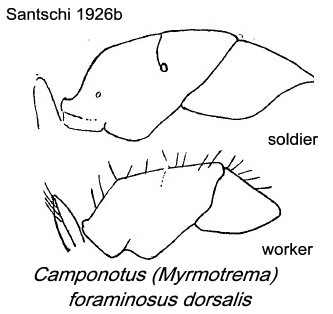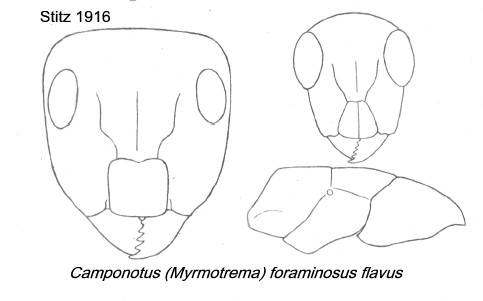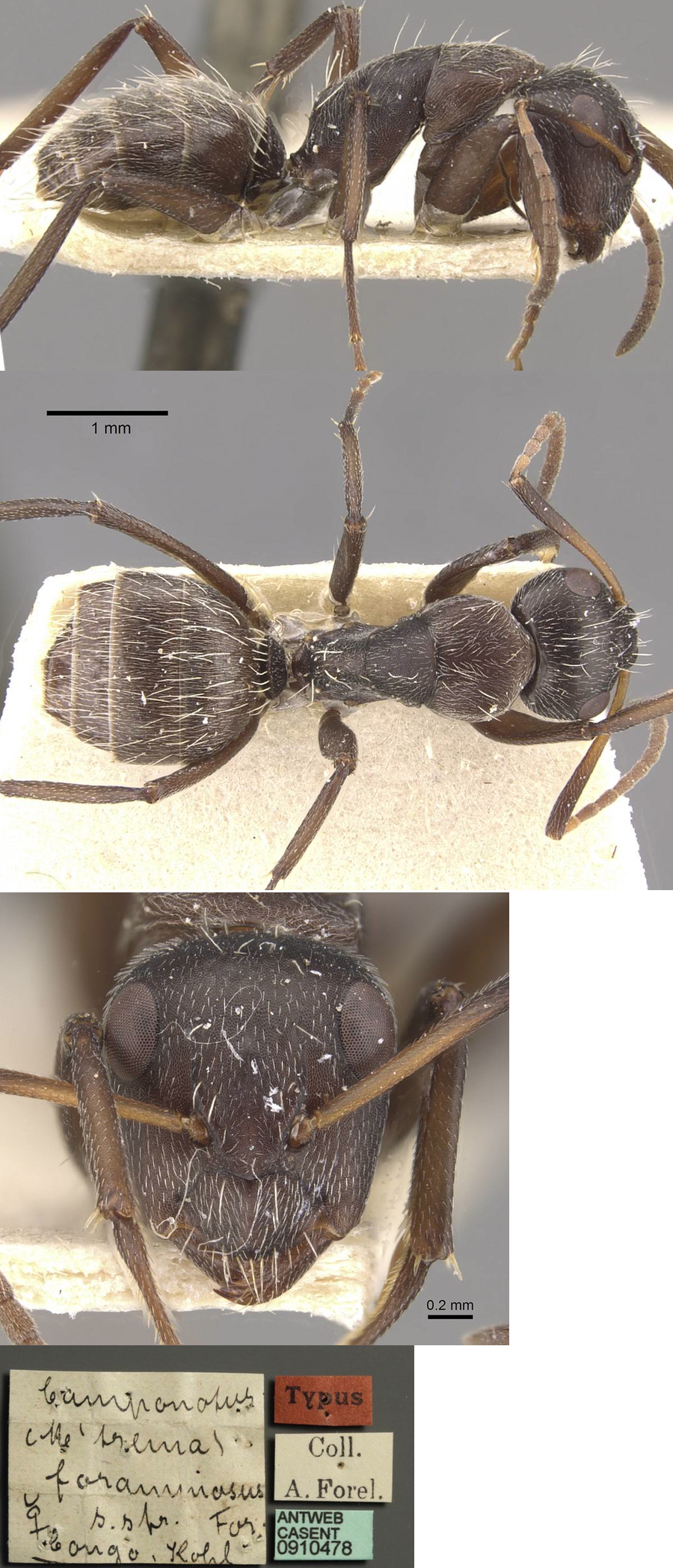Camponotus (Myrmotrema) foraminosus Forel
  Type location Senegal
(Camponotus foraminosus n.
sp., Forel, 1879a: 87, major & minor workers) collected at Cape
Verde,
by
Sauss - no images on Antweb (September 2014) Type location Senegal
(Camponotus foraminosus n.
sp., Forel, 1879a: 87, major & minor workers) collected at Cape
Verde,
by
Sauss - no images on Antweb (September 2014)
subspecies
aldabrensis (Camponotus
foraminosus For. r. aldabrensis
nov. stirps, Forel, 1897c: 203, major & minor workers) Aldabra
Is, Voeltzkow - see http://www.antweb.org/specimenImages.do?code=casent0101126
chrysogaster (Camponotus
foraminosus For. sottosp. chrysogaster
n. subsp., Emery, 1895a:
182, major; Forel, 1907g: 90, queen & male) Ethiopia,
Arussi Galla - see bottom
honorus
(Camponotus carbo Em. subsp. honorus n. subsp., Forel, 1910c:
268, minor worker; stirps of foraminosus
Santschi, 1915c: 268) Ethiopia, West, Ilg - see http://www.antweb.org/specimenImages.do?code=casent0910479
cuitensis (Camponotus
foraminosus Forel r. Cuitensis
n. stirps, Forel, 1901d: 309, minor worker) Angola,
Cubango-Cuito - see http://www.antweb.org/specimenImages.do?code=casent0910501
but note the specimen appears quite bright reddish-orange and, so, may
be a distinct species
deductus
(Camponotus
foraminosus Forel var deducta
n. var., Santschi, 1915c: 268, in key, minor worker, not in Wheeler,
1922) Nigeria,
Calabar - see http://www.antweb.org/specimenImages.do?code=casent0911835
dorsalis (Camponotus
(Myrmotrema) foraminosus For. stirps dorsalis n. st., Santschi, 1926b:
265, major & minor workers and
queen) Zaïre (St Gabriel, Kohl) - see below as "Typus"; &
Tanzania (Turiani,
A Loveridge)
flavus (Camponotus
(Myrmotrema) foraminosus For. r. flavus n. stirps, Stitz, 1916: 397,
illustrated, major & minor workers) Congo, collected at
Fort Crampel, by Schubotz - no images on Antweb (September 2014)
(see Bolton, 1995)  . .
|
 Forel's
(1879a) description of the type major is at Forel's
(1879a) description of the type major is at  . Forel's (1886f) notes on the major are at . Forel's (1886f) notes on the major are at
 . Forel's (1913e)
description of the queen is at . Forel's (1913e)
description of the queen is at  . Forel's (1897c) description of aldabrensis
is at . Forel's (1897c) description of aldabrensis
is at  . Emery's (1895a)
description of chrysogaster is at . Emery's (1895a)
description of chrysogaster is at  . Forel's (1901d)
description of cuitensis is at . Forel's (1901d)
description of cuitensis is at  . Forel's (1910c)
description of honorus is at . Forel's (1910c)
description of honorus is at  . Forel's (1910c)
reviewed the then knowledge, this is at . Forel's (1910c)
reviewed the then knowledge, this is at  . Santschi's (1915c) key
is at is at . Santschi's (1915c) key
is at is at  .
Stitz's (1916)
illustrated description of flavus is at .
Stitz's (1916)
illustrated description of flavus is at  . Santschi's (1926b)
description of dorsalis is at . Santschi's (1926b)
description of dorsalis is at  . .
|
 The original description by Forel (1879a) is - The original description by Forel (1879a) is -
MAJOR - TL 7.8 mm; head and sculpturation similar to Camp.
grandidieri, described from Madagascar, but the body shape and
pubescence reveal differences. Head more or less triangular, with
rounded sides. Mandibles short, narrow, with sparse hairs, 6 teeth;
coarsely puncturate and finely striate between the punctures. Clypeus
almost rectangular (square), without a carina, almost without an
anterior lobe; anterior border scalloped laterally, straight medianly.
Thorax quite low, enlarged anteriorly, strongly compressed posteriorly
(like that of mina, type location Mexico, but shorter and less
depressed). Dorsum of thorax shallowly convex and rounded transversely
but near straight longitudinally to the propodeum, which is very
narrow, of the same length as the declivity; the transition being an
obtuse rounded angle; declivity near flat. Thorax sutures distinct but
not impressed. Petiole scale low (as in mina). Gaster small, a
short wide oval. Legs and antennae of medium length.
Matt or slightly silky; thorax, gastral dorsum, head, and anterior of
femora puncturate like the head of a thimble; this puncturation very
finely packed. Antenna, legs and genae finely or fairly finely
reticulate. Petiole scale, declivity of propodeum and gaster dorsum
transversely reticulo-rugose. Head richly sprinkled with large
piligerous points; on the genae these points become large rounded
hair-pits, each giving rise to a small hair (as in grandidieri),
overall giving the head a scabrous appearance.
Whole of body covered with a grey-yellow pubescence, of moderate
length; sparse on the head, lower legs, scapes and ventral gaster; more
abundant on the thorax, femora and lateral gaster; very dense and
slightly golden on dorsum of gaster hiding the chitinous cuticle and
looking like a fur coat. Erect hairs are sparse on the whole body, and
absent on the tibiae and scapes.
Colour black; a narrow yellowish border to the gastral segments;
appendages and anterior border of head mostly brown-red; ends of legs
and antennae and the edges of the thorax black-brown and brown-black.
Single specimen from Senegal, Cap Vert, near Dakar, collected
by Sauss. [Saussure, who either collected it or had it in his personal
collection].
|
 Collingwood (1985) refers to it as having large shallow
punctures on the head, as does Camponotus ilgii,
but the latter also has a deep metanotal groove. Collingwood (1985) refers to it as having large shallow
punctures on the head, as does Camponotus ilgii,
but the latter also has a deep metanotal groove.
Wheeler (1922) listed findings from throughout
sub-Saharan Africa, with West African records from Nigeria (Old
Calabar, by Bates), Cameroun (Conradt). He wrote, however, that
it is an extremely variable species, the Zaïre specimens,
according to Emery, having more abundant and more golden pubescence
than Congo specimens sent by Forel as corresponding to the
type. Zaïre collections included nests in hollow twigs and cavities of
branches.
Nests in dead wood on living trees. It often nests in
old dry pods on cocoa trees (Forel, 1915c, from St. Gabriel, by Kohl).
Apparently wholly tends aphids, but does not build tents. Also forages
widely across the ground and on many plants; including native trees and
herbaceous vegetation, kola and plantain.
In Ghana, speculatively, this is the species
reported as Camponotus foraminosus Forel, by Majer (1975) who
collected workers on cocoa by pkd at Kade. Room (1971) collected it
from one cocoa canopy sample, and also listed Camponotus near foraminosus
from six cocoa canopy samples; he found it to be
positively associated with Crematogaster
africana.
The distribution comment by Bernard (1952), reporting
its finding in Guinea, Mt. Nimba savanna areas of Ziéla and
Kéoulenta, was that it is a common insect of the lowland plain.
Note - in their report on species from Saudi
Arabia, Collingwood & Agosti (1996) separated it from carbo
in their key as body colour uniformly dark; head with front part with
large scattered pits, genae with projecting hairs, head with projecting
hairs restricted to anterior of eyes, antennae not broadening to apex.
That differs from the specimen shown below which I feel matches the
type description
- there are no projecting hairs on the genae, there are projecting
hairs on the front of the head right back to the occiput and the scape
does expand apically. |
 The
photomontage of a major worker is
collated from http://www.antweb.org/specimen.do?name=casent0910477 The
photomontage of a major worker is
collated from http://www.antweb.org/specimen.do?name=casent0910477
Note: Although this bears a "Typus" label it is not from the original
type collection but matches the description in Santschi (1926B) of "dorsalis".
Santschi described this as black and the usual Antweb magenta tint has
to be compensated for although the fresh workers I show below do have
reddish areas on the head, etc.
|
 The
photomontage of a minor worker is collated from http://www.antweb.org/specimen.do?name=casent0910478 The
photomontage of a minor worker is collated from http://www.antweb.org/specimen.do?name=casent0910478
The comment above applies to this specimen.
|
Oxford University Museum
specimens
Camponotus (Myrmotrema) foraminosus
B Taylor det.
|
Liberia
E Poirier
Liabala
PF 9
|
2.iv.2013
Nimba County
07°31’06" N
08°35’34" E
|
Pitfall trap
Secondary forest
473 m asl
minor
|
1
|
 |
Camponotus (Myrmotrema) foraminosus
B Taylor det.
|
Liberia
E Poirier
Liabala
PF 17
|
2.iv.2013
Nimba County
07°31’06" N
08°35’34" E
|
Pitfall trap
Secondary forest
473 m asl |
1
|
 |
Camponotus (Myrmotrema) foraminosus
B Taylor det.
|
Liberia
E Poirier
Liabala
PF 18
|
2.iv.2013
Nimba County
07°31’06" N
08°35’34" E
|
Pitfall trap
Secondary forest
473 m asl
|
3
|
 |
Camponotus (Myrmotrema) foraminosus
B Taylor det.
|
Benin
J-F Vayssieres
RVA 3053.1
|
20.iii.2013
Koro
09°22'21'' N
02°40'13'' E
|
Mangifera indica orchard
prey of Oecophylla longinoda
1500-1600 h
minor
|
1
|
 |
Camponotus (Myrmotrema) foraminosus
B Taylor det.
|
Benin
S Tchibozo
|
29.i.2007
06°55’03.7 N
02°24’44.6 E
|
Forêt de
Gnanhouizoumè
Forêt fourmis (forest ants)
|
3
|
 |
Camponotus (Myrmotrema) foraminosus
B Taylor det.
|
Benin
S Tchibozo
|
28.ii.2007
06°55’32.8 N
02°29’13 E
|
Forêt de Gbèvozoumè
Lisière fourmis (forest edge/ border ants)
|
3
|
|
Camponotus (Myrmotrema) foraminosus
B Taylor det.
|
Cameroun
A Fotso Kuate
Camponotus sp15
|
17.vii.2007
Awae II
03°54'30" N
11°25'58" E
|
Quadrat in fallow
|
2
|
 |
Camponotus (Myrmotrema) foraminosus
B Taylor det.
|
Cameroun
A Fotso Kuate
Camponotus sp11 |
18.v.2007
Matomb
03°54'30" N
11°25'58" E
|
Quadrat in fallow |
1
|
 |
Camponotus (Myrmotrema) foraminosus
B Taylor det.
|
Congo
E Zassi
12-t-2-1
|
8-9.xi.2007
Lésio-Louna
03°16'21.7" S
015°28'12.5" E
|
Gallery Forest; 24h
pitfall trap
|
2
|
 |
|
 The
photomontage is of a major worker from Cameroun, Awae II;
17.vii.2007; Collector A Fotso Kuate. Matching the Stitz (1916)
illustrations. The
photomontage is of a major worker from Cameroun, Awae II;
17.vii.2007; Collector A Fotso Kuate. Matching the Stitz (1916)
illustrations.
|
 The
photomontage is of a minor worker from Cameroun, Awae II, as
above. The
photomontage is of a minor worker from Cameroun, Awae II, as
above.
|
 The photomontage is
of a major worker from Congo, Réserve
de Lésio-Louna; collected by Eric Zassi (nsp 7). The photomontage is
of a major worker from Congo, Réserve
de Lésio-Louna; collected by Eric Zassi (nsp 7).
|
 The photomontage is
of a media worker from Congo, Réserve
de Lésio-Louna; collector Eric Zassi. Note -
Forel (1910c) described a "media" of honorus, although he had
never described a minor of the type. The Stitz illustration of flavus
suggests the minor is quite distinct from the major. The photomontage is
of a media worker from Congo, Réserve
de Lésio-Louna; collector Eric Zassi. Note -
Forel (1910c) described a "media" of honorus, although he had
never described a minor of the type. The Stitz illustration of flavus
suggests the minor is quite distinct from the major.
|
 The
photomontage of a major worker from the type collection of chrysogaster
is
collated from http://www.antweb.org/specimen.do?name=casent0905422 The
photomontage of a major worker from the type collection of chrysogaster
is
collated from http://www.antweb.org/specimen.do?name=casent0905422
Note: Although Emery (1895a: 182) gave this as a "major", the size and
head
compared with the majors above suggest that it is a media worker.
|
Oxford University Museum
specimens - possibly the honorus form
Camponotus (Myrmotrema) foraminosus honorus
B Taylor det.
|
Central African
Republic
P Annoyer
Camp 5-01
|
17.ii.2005
Dzanga-Sangha
02°53’25.9" N
16°10’26.4" E
|
seen 1300 to 1800;
409m asl
|
1
|
 |
Camponotus (Myrmotrema) foraminosus honorus
B Taylor det.
|
Liberia
E Poirier
Yekepa
SLAM 4
|
29.iii.2013
Nimba County
07°33’38" N
08°32’33" E
|
SLAM trap
Secondary forest
473 m asl
|
1
|
 |
|
 The photomontage is
of a minor from the Central
Africa Republic, Dzanga-Sangha NP, Camp 3; collector Philippe
Annoyer. The photomontage is
of a minor from the Central
Africa Republic, Dzanga-Sangha NP, Camp 3; collector Philippe
Annoyer.
|
 The photomontage is
of a minor from the Liberia; collector E Poirier (Yekepa SLAM
4). The photomontage is
of a minor from the Liberia; collector E Poirier (Yekepa SLAM
4).
|
|